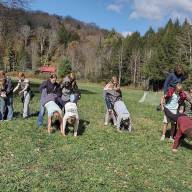By Alice Rodgers
Whether it is a place to cool off or a secret honey hole where you can fly fish while enjoying the river's natural beauty, most of us have a favorite water spot in the Mad River Valley. Hidden falls, secret ponds, river shallows, and swim holes offer respite from the summer heat and multiple opportunities to satisfy our love for water recreation. Regardless of the location of your favorite place, we share the responsibility to engage in safe swimming practices, respect other users, and steward our resources.
The summer brings a surge in activity on the river and at swim holes. This uptick in usage comes with downsides. Challenges such as dangerous overflow parking on roads, more garbage and litter, improper disposal of human and pet waste, unleashed dogs, trespassing on private property, and a marked increase in trail erosion. These problems negatively impact our natural resources, degrade the experience for visitors and residents alike, and put at risk continued public access to swimming holes. To address these concerns the Vermont Swimming Hole Collaborative provides the following guidelines:
- “Carry-in, carry-out” and “Leave No Trace” where trash and recycling bins are not present, or where bins are full.
- Use designated bathroom facilities only; human waste (and dog waste) can lead to dangerous bacteria in the water.
- Always keep dogs leashed to keep them and others safe or leave them at home. Pick up and properly dispose of dog waste.
- When a parking lot is full, come back later or visit a different site; do not park on private property or in the traveled area of roads.
- Do not trespass on private property and respect “no trespassing” signs.
- Read and respect all signage at swim hole sites.
- Be considerate of others and the neighborhood.
- Help keep Vermont waters clear; staying on the trails reduces erosion and saves plants.
While swim holes offer wonderful recreational opportunities, swimming at an unmanaged location comes with risks. Even the most seasoned water enthusiasts can be surprised by changing water conditions. “Staying safe at swim holes begins with an awareness of your surroundings whenever going to a new place, or even a favorite spot,” said Holly Knox, recreation program manager for the USDA Forest Service, Green Mountain National Forest. “Knowing the unique features of each swim hole you visit will help you understand where swift currents and cliffs are located, and whether it is safe for you to plunge in.” Remember that water is wild, and always changing. Heavy rains, floating or lodged debris, or even extended periods of heat and drought can change currents, affect depths, and alter the underwater structure of a wild body of water. Before entering the water assess the conditions. Has it rained heavily in the last several days? Swollen rivers and fast-moving currents can create dangerous conditions for days after a heavy rain event. If there have been recent heavy rains, conditions may be dangerous, even if it is a clear, sunny, calm day. FYI, after the recent flooding, Vermont’s chief medical officer Mark Levine recommended staying out of the water for a while because flood waters can carry toxic ingredients (e.g., E.coli). Be prepared to make alternate plans if there have been heavy rains or recent flooding.
Even when conditions are ideal, exercise good judgment. Don’t jump off cliffs or dive into waterfall pools. Unseen objects, such as logs and boulders may be under the water’s surface. Even crystal-clear pools may be shallower than you think. Don’t swim above, or under, waterfalls: Heavy currents can wash people over falls, and undertows can trap swimmers underwater. Avoid swimming above, or directly beneath waterfalls. Remember that safe swimming is sober swimming. Drugs and alcohol can dull your senses, impair your judgment, and slow response time. Always exercise caution when swimming in natural water bodies and never swim alone.
The Mad River Valley is blessed with dozens of swim holes, fishing streams, and quiet spots on the Mad River. As noted by Steve Libby, executive director of the Vermont River Conservancy, “when we work together, we can help protect and take care of these sites for people to enjoy for generations to come.” Respect nature, use good judgment, be responsible, and get outside and enjoy the water!
This month’s volunteer opportunity: help steward the river by joining forces with Friends of the Mad River. For more information, go to: https://www.friendsofthemadriver.org/volunteer.html
For more information on recreation in The Valley, visit https://www.mrvrd.org/.













